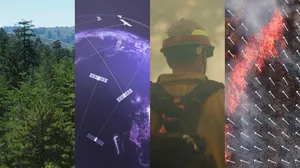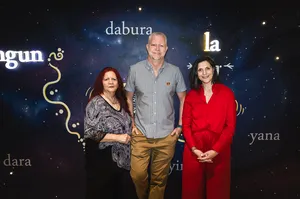How Google AI is helping restore Australia’s giant kelp forests
There’s a huge invisible forest off the south coast of Australia. It’s out of sight, underwater, and was once teeming with giant kelp.
This vast forest forms an iconic part of the Great Southern Reef, an ecosystem straddling five Australian states and home to thousands of marine organisms, from fairy penguins and leafy sea dragons, to the critically endangered red handfish. But unlike the iconic Great Barrier Reef, most have never heard of this reef - despite 70% of Australians living within 50km of it.
Once far bigger, these underwater giant kelp forests are dying due to climate change and increasing sea temperatures. Alarmingly, in Tasmania for instance only 5% of giant kelp remains today.
More than 750 million people live within 50km of a kelp forest - and many don’t even know they are there. Image credit: Kelp Forest Alliance collection and GRID-Arendal.

I was lucky enough to visit some of the giant kelp canopies near Hobart, Tasmania, and was stunned - both by its beauty, and by how little of it was left behind. Like forests on land, the kelp forests are crucial for countless species that depend on it for shelter, food and reproduction. When they disappear, it affects the entire ocean and we lose crucial wildlife.
And with 2023 officially the hottest year on record, the giant kelp forests are at more risk than ever before.
That’s why Google Australia and Google Research have teamed up with CSIRO, Institute for Marine and Antarctic Studies (IMAS), The Nature Conservancy, Great Southern Reef Foundation and Kelp Forest Alliance to tackle the problem. Under the Digital Future Initiative, our researchers are working together to study the giant kelp that still exists with the help of AI, aiming to regrow and restore the forest so that the reef's diverse ecosystem continues to have a home.
Before the kelp forests can be protected, scientists need to know where exactly the remaining canopies are located. Imagine trying to identify a particular tree species in thousands of square kilometres of forest. And then imagine doing it underwater. Manually identifying and tracking canopies can be challenging, costly and cumbersome.
With the power of AI, combined with geospatial mapping technology and our partner NGIS, we can identify the remaining forests at a speed and scale otherwise not humanly possible. We are using Google Earth Engine and Google Cloud’s AI platform Vertex AI to locate and analyse kelp forests in more than 7,000km2 of satellite imagery for the first time. This helps provide researchers with a complete picture of these ecosystems so they can create an efficient, reliable and long-term monitoring strategy.
Example of the Google Earth Engine map showing known Giant Kelp locations in Tasmania.

Our researchers are also working with CSIRO and IMAS to use Google AI to analyse the 5% of kelp that has survived increasing water temperatures. By identifying the specific genetic patterns that make some kelp resistant to heat, we can then grow more of these kelp varieties - and take significant steps towards restoring our magnificent kelp forests.
As a first-of-its kind, this research project won’t just make a difference in Australia, but could have a positive impact globally. To support the restoration of giant kelp forests nationwide, we’re making the geospatial map accessible to all scientists, while the AI research tools we used are already available open-source.
After being harvested, Giant Kelp enters CSIRO and IMAS labs in Hobart where it is studied and grown to ultimately restore the forests off the coast of Tasmania. Microscope Image credit: Eileen Lee.

Partnerships like these are at the heart of our Digital Future Initiative - a $1bn investment in Australian research, partnerships and infrastructure aimed at building a stronger digital future for all. Working in collaboration to tackle some of Australia’s most difficult challenges - from climate, to healthcare and accessibility - shows the incredible potential of applying AI boldly and responsibly, together.
That’s the promise of a strong digital future - where Australians have the tools and skills to thrive, propel breakthroughs, stay resilient and safeguard the things we treasure for future generations – including the Great Southern Reef.
As we work with our partners to preserve and restore the giant kelp forests, we also want to raise awareness of its plight and the broader Great Southern Reef with a collection on Google Arts & Culture, launching today. Discover everything from how this incredible forest is helping scientists uncover secrets to reforesting the ocean, to the amazing creatures that depend on these ecosystems, and the significance of kelp to Aboriginal communities with artist Emma Robertson.
To learn more about how you can join us and help the giant kelp, head over to the Kelp’s Fight for Climate Change collection at goo.gle/invisible-forest.





